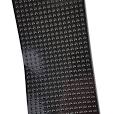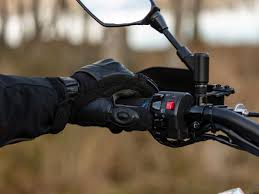Enhance Your Riding Experience with Motorcycle Tank Grips

Exploring the Benefits of Motorcycle Tank Grips
Motorcycle tank grips are a simple yet essential accessory that can greatly enhance your riding experience. These grips are typically made of durable materials like rubber or silicone and are designed to be attached to the sides of your motorcycle’s fuel tank.
One of the main benefits of using tank grips is improved rider control. By providing a textured surface for your knees to grip onto, tank grips help you maintain a secure and stable position on the bike, especially during high-speed maneuvers or tight turns. This added grip can reduce rider fatigue and improve overall comfort during long rides.
In addition to enhancing control, tank grips also offer protection for your motorcycle’s paintwork. Constant rubbing of your knees against the tank can cause scratches and wear over time. Tank grips act as a barrier between your body and the tank, helping to preserve its appearance and resale value.
Furthermore, tank grips can contribute to improved aerodynamics. By allowing you to maintain a more streamlined posture on the bike, these grips help reduce wind resistance and drag, resulting in smoother rides and potentially better fuel efficiency.
Installing tank grips is a relatively simple process that can be done at home with basic tools. Most grips come with adhesive backing for easy attachment to the tank surface. It’s important to ensure proper placement and alignment for maximum effectiveness.
Whether you’re a seasoned rider looking to enhance performance or a beginner seeking greater comfort and confidence on the road, motorcycle tank grips are a worthwhile investment. Explore the range of options available on the market today and discover how these small but impactful accessories can make a big difference in your riding experience.
9 Essential Tips for Installing and Maintaining Motorcycle Tank Grips
- Ensure the tank surface is clean and dry before applying grips.
- Follow manufacturer’s instructions for proper installation.
- Apply pressure evenly when attaching the grips to prevent air bubbles.
- Use a heat gun or hairdryer to help adhere the grips securely.
- Regularly check the grips for any signs of wear or peeling.
- Avoid using harsh chemicals that may damage the grips or tank surface.
- Choose a grip design that provides adequate traction and comfort for your riding style.
- Consider removing old grips carefully to avoid damaging the tank paintwork.
- Customise your tank grips with colours or patterns to match your bike’s aesthetics.
Ensure the tank surface is clean and dry before applying grips.
To maximize the effectiveness of motorcycle tank grips, it is crucial to ensure that the tank surface is clean and dry before applying the grips. A clean surface free from dirt, oil, or residue will allow the grips to adhere securely and prevent any potential slippage during rides. By taking the time to properly prepare the tank surface, riders can ensure a strong and long-lasting bond between the grips and the tank, enhancing both control and comfort while out on the road.
Follow manufacturer’s instructions for proper installation.
When it comes to installing motorcycle tank grips, it is crucial to follow the manufacturer’s instructions carefully for proper installation. Each grip may have specific guidelines and recommendations to ensure a secure and effective attachment to the tank surface. By adhering to these instructions, riders can guarantee that the grips are installed correctly, maximizing their performance benefits such as improved control, comfort, and protection for both the rider and the motorcycle.
Apply pressure evenly when attaching the grips to prevent air bubbles.
When installing motorcycle tank grips, it is crucial to apply pressure evenly during the attachment process to prevent the formation of air bubbles. By ensuring a smooth and consistent application of pressure, you can effectively adhere the grips to the tank surface without any trapped air pockets. This not only helps in achieving a secure and durable grip but also ensures a neat and professional finish. Proper installation techniques, such as applying even pressure throughout, can significantly enhance the effectiveness and longevity of your tank grips, providing you with a reliable and comfortable riding experience.
Use a heat gun or hairdryer to help adhere the grips securely.
To ensure a secure and effective attachment of motorcycle tank grips, a useful tip is to use a heat gun or hairdryer during the installation process. Applying heat to the adhesive backing of the grips can help soften the material, making it more pliable and enhancing its ability to adhere firmly to the tank surface. By carefully heating the grips before pressing them into place, you can improve their bond and ensure they stay securely in position, providing you with optimal grip and control during your rides.
Regularly check the grips for any signs of wear or peeling.
It is crucial to regularly inspect your motorcycle tank grips for any indications of wear or peeling. Over time, the constant friction and pressure from your knees can cause the grips to deteriorate. By checking them frequently, you can identify any issues early on and take necessary steps to replace or repair them, ensuring optimal grip performance and rider safety on the road.
Avoid using harsh chemicals that may damage the grips or tank surface.
To ensure the longevity and effectiveness of your motorcycle tank grips, it is crucial to avoid using harsh chemicals that may cause damage to the grips or the tank surface. These chemicals can degrade the materials of the grips and potentially harm the paintwork or finish of your motorcycle’s tank. Instead, opt for gentle cleaning solutions and soft cloths when maintaining your tank grips to preserve their quality and appearance for longer periods. By taking care to avoid harsh chemicals, you can extend the lifespan of your tank grips and maintain a safe, secure grip during your rides.
Choose a grip design that provides adequate traction and comfort for your riding style.
When selecting a motorcycle tank grip, it is crucial to choose a design that offers the right balance of traction and comfort tailored to your specific riding style. Whether you prefer a more aggressive grip pattern for enhanced control during spirited rides or a softer, more ergonomic design for long-distance touring comfort, finding the perfect grip can significantly impact your overall riding experience. By considering factors such as material quality, texture, and thickness, you can ensure that your chosen tank grip not only provides adequate traction but also maximises comfort and support according to your individual preferences on the road.
Consider removing old grips carefully to avoid damaging the tank paintwork.
When installing or replacing motorcycle tank grips, it is crucial to consider removing old grips carefully to avoid damaging the tank’s paintwork. Taking the time to remove the old grips with caution can help preserve the integrity of the tank’s surface and prevent unsightly scratches or marks. Using gentle techniques and possibly a suitable adhesive remover can make the process smoother and ensure that your motorcycle maintains its aesthetic appeal for years to come.
Customise your tank grips with colours or patterns to match your bike’s aesthetics.
Customising your motorcycle tank grips with colours or patterns to match your bike’s aesthetics is a fantastic way to add a personal touch to your ride. By choosing tank grips that complement the design and colour scheme of your bike, you can create a cohesive and stylish look that sets your motorcycle apart. Whether you prefer bold, eye-catching patterns or subtle, understated hues, customising your tank grips allows you to express your individuality and showcase your unique sense of style while enjoying the practical benefits they provide.



